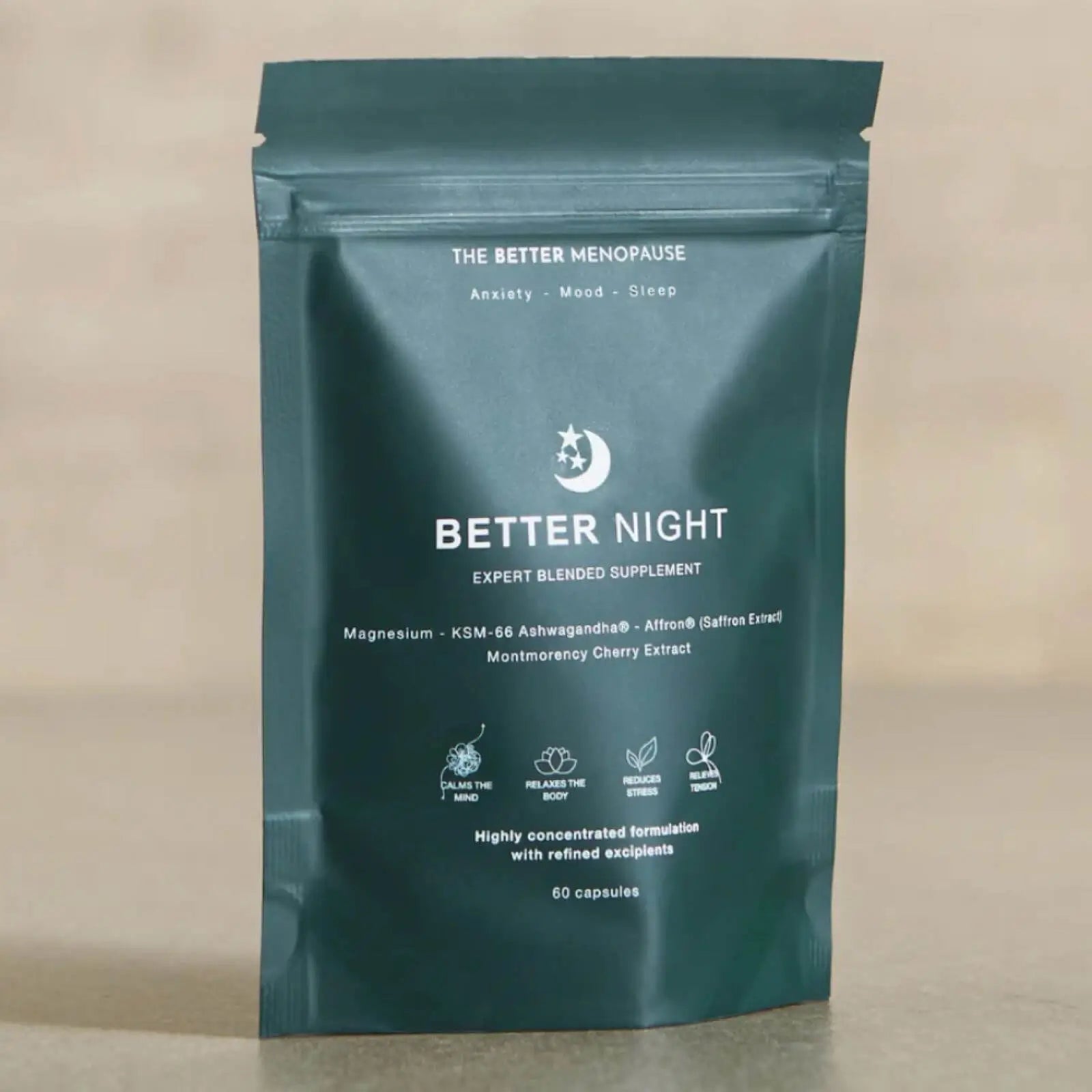
The links between menopause and leg pain, and the approaches that could help
What does menopause leg pain feel like, what’s the link to changing hormone levels and what could help ease your symptoms?
Pain in the muscles and joints of your legs is a common symptom of both perimenopause and menopause. These issues are often worse at night and you may feel a variety of pain sensations in different areas of your legs.
Changing levels of hormones like oestrogen and progesterone play an important part in menopause leg pain, with links to the health of your muscles and joints, how you experience pain and your risk of developing osteoporosis.
You’re also more likely to get restless legs syndrome at this time, which can come with its own types of leg pain.
There are several approaches you can try to help treat menopause leg pain, including regular stretching, staying hydrated, hormone replacement therapy and taking certain supplements.
We’ll explain all of this in more detail below, as well as looking at whether your menopause leg pain could go away on its own, and when you should see a doctor.
Studies have shown that the friendly bacteria in The Better Gut probiotic supplements can increase bone density and reduce the risk of osteoporosis, as well as helping with a range of other menopause symptoms.
To find out more, visit The Better Menopause. And use the discount code WELCOME10 for 10% off your first order.
What links menopause, hormones and leg pain?
When you enter perimenopause – the years leading up to menopause – your levels of reproductive hormones like oestrogen and progesterone begin to fluctuate. As you near menopause, these levels drop for good.
These changes are linked to a range of menopause symptoms, and that includes musculoskeletal pain – aches and pains in your muscles and joints.
Studies suggest that over 70% of women will experience this sort of pain at some point during menopause – and your legs are one of the most common places to feel it.
There are several reasons why reduced hormone levels can lead to increased leg pain during menopause.
Oestrogen and your muscles
Oestrogen helps to protect your muscles from damage and inflammation due to exercise or injury. When levels are low, this may lead to increased pain.
If you’ve noticed that your legs ache more than they used to after a workout, this could be part of the reason.
Oestrogen and your joints
Oestrogen also plays an important role in the production of collagen, which is essential for the health of the cartilage that cushions your joints and the tendons that connect your muscles to your bones.
Many women experience pain in their knees and hips during menopause. In other cases, problems that start in your hips can lead to pain radiating down into the muscles of your legs.
Oestrogen and cortisol
As oestrogen decreases, your levels of the stress hormone cortisol go up, and increased cortisol can make pain seem more intense.
Because of this, low level aches and pains in your legs that didn’t used to bother you may start to become more noticeable.
Progesterone and pain
Progesterone is another reproductive hormone that’s involved in your experience of pain.
It’s responsible for raising your pain threshold and keeping your muscles relaxed.
Research suggests that changes to progesterone levels during perimenopause could be behind bouts of musculoskeletal pain, such as leg pain.
Oestrogen and osteoporosis
Osteoporosis is a disease that makes your bones weaker and more prone to painful fractures in areas including your legs and hips.
Oestrogen is essential for healthy bones. During menopause, reduced oestrogen levels can lead to a rapid decrease in the density of your bones and an increased risk of developing osteoporosis.
Oestrogen and magnesium
As oestrogen levels fall during menopause, so do magnesium levels. In some cases, this can lead to magnesium deficiency.
Low levels of magnesium can in turn contribute to leg cramps. However, as we’ll explain below, even if you are low in magnesium, it doesn’t necessarily mean that increasing your intake will get rid of your menopause leg pain.
Restless legs syndrome (RLS)
Restless legs syndrome is an irresistible need to move your legs. It’s most common when you’re in bed at night and is often accompanied by pain in your legs, such as burning, throbbing or cramping.
You’re more likely to experience restless legs syndrome, and have worse symptoms, during menopause. Experts think this may be due to the effect of fluctuating oestrogen levels on dopamine, a neurotransmitter involved in the movement of your muscles.
What does menopause leg pain feel like?
How menopause leg pain feels, and exactly where you feel it, varies from person to person. These are some of the symptoms commonly reported by women during menopause:
- cramping
- aching
- burning
- soreness
- sharp/shooting pains in your knees or hips
- heavy legs
- twitching muscles
Menopause leg pain at night
For many women, menopause leg pain is worse at night. Some report being woken up by the pain, especially cramps in their calves or the backs of their legs.
If you have restless legs syndrome, nighttime is definitely when it’s at its worst. Along with the urge to move your legs, you may feel a cramping or burning pain, or a tingling, crawling or fizzing sensation.
5 treatments for menopause leg pain
Depending on the type of leg pain you’re experiencing during menopause, and exactly what’s behind it, there are several approaches that may help.
However, it’s worth being aware that with some of these potential treatments more research is needed before we can say how likely they are to relieve your symptoms.
1. Stretching
If you regularly experience painful cramps, you don’t need anyone to tell you that stretching your calves or hamstrings immediately is essential for relieving the pain.
But studies have shown that regular stretching can also help to prevent nighttime cramps. It’s also important to take the time to stretch your leg muscles after every exercise session.
2. Staying hydrated
As you get older, you become less sensitive to your body’s thirst signals. Your hormones can also impact how thirsty you feel. Dehydration can lead to cramps in your legs.
It’s important to make a conscious effort to drink liquids regularly. The NHS recommends 6 to 8 cups of water a day, but you may need more if you’ve been exercising or sweating due to hot flushes.
3. Hormone replacement therapy
Hormone replacement therapy (HRT), also known as Menopause Hormone Therapy (MHT), replenishes oestrogen and progesterone lost due to menopause. It’s known to help with a range of menopause symptoms, including hot flushes, sleep problems and anxiety.
There’s not a huge amount of research looking at whether HRT can help with leg pain or other musculoskeletal discomfort but a global consensus statement endorsed by the International Menopause Society says that HRT may improve joint pain and muscle pain.
4. Probiotics
Probiotics are friendly bacteria that can have a wide range of health benefits by helping to improve the balance of your gut microbiome.
Studies have shown that five specific strains of probiotics can increase bone density and reduce the risk of developing osteoporosis.
These strains are all found in The Better Gut probiotic supplements, which can also help with a range of other perimenopause and menopause symptoms.
5. Magnesium
As we’ve seen, low levels of magnesium in your blood are linked to an increased risk of leg cramps, so you might think taking magnesium supplements would be the answer.
However, evidence is mixed at best, and many studies have found no improvement.
On the other hand, there is evidence that taking magnesium supplements before exercise can reduce muscle soreness afterwards. So if your post-workout leg pain has been worse since you started the menopause transition, it may be worth trying magnesium.
6. Iron
People with restless legs syndrome often have an iron deficiency. Many women also experience low iron during perimenopause, especially after losing a lot of blood from heavier periods.
If your leg pain is linked to RLS, it might be a good idea to eat more iron-rich foods, such as leafy green vegetables, beans and pulses, dried fruit and moderate amounts of meat.
If your doctor thinks you have low iron – also known as iron deficiency anaemia – they may prescribe iron tablets.
Does menopause leg pain go away?
Whether your menopause leg pain goes away by itself could depend on a number of factors, including exactly what’s causing it.
For some women, it’s during the perimenopause, when hormones levels are fluctuating, that symptoms are at their worst, and many find they improve as they get closer to menopause.
However, studies suggest that the risk of experiencing musculoskeletal issues like leg pain is, on average, about the same after menopause as it is during perimenopause. So for some women it could be when oestrogen levels have settled at their lowest that these symptoms become most troublesome.
When to see a doctor
The NHS recommends seeing a doctor if:
- you have leg cramps that regularly disturb your sleep
- the cramps last for longer than 10 minutes
- you also have swelling or numbness in your legs
- you keep getting leg pain when you exercise
Summary
Pain in the muscles and joints of your legs are common symptoms of perimenopause and menopause. You may feel cramping, aching or burning sensations or get sharp pains in your knees or hips.
Menopause leg pain is often worse at night and may include restless leg syndrome, where you have an irresistible urge to move your legs.
Changing hormone levels due to the menopause transition can have a significant impact on leg pain, increasing inflammation and wear to your muscles, joints and bones and making your experience of pain more intense.
Regular stretching and staying hydrated can reduce leg cramps, while taking magnesium supplements may help with muscle soreness after you exercise. Experts also say that hormone replacement therapy may improve joint and muscle pain during menopause.
The friendly bacteria in The Better Gut probiotic supplements can increase bone density and reduce your risk of developing osteoporosis.
They can also help with a range of other menopause symptoms, from anxiety to brain fog, hot flushes to vaginal and urinary health.
To find out more, visit The Better Menopause. And use the discount code WELCOME10 for 10% off your first order.


